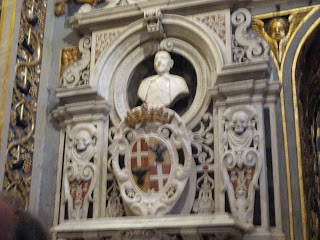Yesterday I ventured to one of the most famous churches in Europe. The St. John's Co-Cathedral in Valletta, Malta, was named after the patron saint of the Knights Hospitaller and was designed to be in the exact center of their new capital after the Siege of Malta in 1565. The church's solemn exterior gives absolutely no indication of the gold encrusted beauty within. Starting a bit tiringly, because as usual I had to walk up and down Republic Street twice before I could find a massive cathedral (I am really starting to think I need a map to find the door of my own house). My lack of direction aside, I found an entrance, that was not an entrance but an exit, so my swift trip to the other corner of the building finally yielded a welcoming "Visitor's Entrance" banner above the limestone arch of its entrance. Again, starting without the excitement one would expect of an employee who spends her days in one of the most beautiful interiors in the world with detail, baroque style, tapestries, along with thousands of other treasures from the Order, I actually was yelled at for having the audacity to give her a fifty euro bill for my admission fee. The entrance fee was six euros, but after the first time she had asked if I had a smaller bill and my answer was a tack "no," the interaction should have stopped. Instead my money was taken from me with an unpleasant eyeroll and my change dropped on the counter in front of me, inches from my open hand, but maybe she had a hard day of standing in air conditioned grandeur. Who knows?
Conveniently, my entrance fee included an audio tour guide which was very informative, but again owing to the catacomb like maze of the church and the velvet ropes that where strewn just about everywhere (plus restoration construction), I missed about half the locations in the church. The entire right side of the chapel was never explored, owing to both my incompetence an a failure to realize the brochure they had briefly handed me included a map (which I was very unhappy to discover only hours ago). Minus my misfortune, I was able to see the beauty of the unsubtle baroque architecture and see how every inch of the Cathedral was adorned in gold, paint, or artifacts. Other than the building itself, I was also able to see the Flemish Tapestries which are the largest complete set of tapestries known to mankind. They depict the life of Christ, his baptism, amongst other religious scenes. One of the tapestries even bears its buyer Grand Master Ramon Perellos y Roccaful. Unfortunately, visitors are not allowed to photograph any of the collections, so any photos of the Flemish Tapestries are going to be stolen directly from St. John's Co-Cathedral's own website. Also beautiful and unable to be photographed by me where the Choral books which are essentially giant prayer books that contain gold leaf illustrations and sung parts of services that were gifted by three grandmasters. Finally, my favorite unphotographical museum piece was the Ciro Ferri Monstrance which is this huge beautiful housing that originally contained the most sacred relic the Knights of St. John ever possessed: the forearm of their patron saint, Saint John. The forearm that baptised Jesus Christ was held in this Monstrance, and the arm was further encrusted in gold and precious stones within a reliquary until Napoleon "obtained" it after he invaded Malta. With the reliquary stolen, the actual relic of St. John's forearm was taken by the last Grandmaster Ferdinand von Hompesch as he fled the island. The Cathedral was extremely beautiful, and one could not study the Knights of St. John without visiting their most prominent work, their most prominent contribution to Valletta, and their most prominent contribution to Catholicism.
Fist my "borrowed" photos from stjohnscocathedral.com:
 |
| Flemish Tapestries with Choral Books in the Center |
 |
| Choral Books |
 |
| Ciro Ferri Monstrance |
Now the pictures I actually took:
Very few of them are going to have captions due to most of them just being photos of the fantastic details and baroque style of the church. Also I would be remiss not to claim a bit of laziness, and ignorance to what a lot of the gorgeous art is, played its part as well.
 |
Except this one, this is one of my favorite photos I have ever taken.
The bottom half with the two lions is my desktop background at Wexford Health Sources (where I intern). |
 |
| Chapel of Germany |
 |
| The only reason I took this photo is so that I would remember what this was. |
 |
| Close up of the mantelpiece of the Chapel of Germany. |
 |
Skylight with the Cross of the Knights of St. John
(or Maltese Cross)
(or Amalfi Cross)
 |

































No comments:
Post a Comment